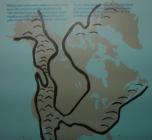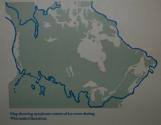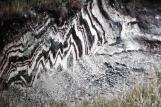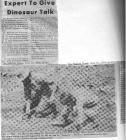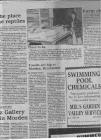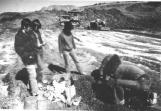1
The Western Interior Seaway represents a fraction of time in the Earth's history. This fraction of time is represented by a unique fauna (animal life) seen in the Canadian Fossil Discovery Centre's collection.3
Eighty to ninety million years ago North America was separated by the Western Interior Seaway into two land masses.Sea levels altered drastically during the Cretaceous Period (130-65 million years ago) with three inlets protruding onto the continent at various times. Inlets were from the Arctic Ocean, Hudson Bay and the Gulf of Mexico.
Approximately 90 million years ago, all three inlets united and formed the Western Interior Seaway. The fossil remains in the Pembina Hills are indications of the life forms swimming in this seaway.
4
The Western Interior Seaway diorama1982
Canadian Fossil Discovery Centre, Morden, Manitoba, Canada

5
This diorama, seen at the Canadian Fossil Discovery Centre, provides a glimpse of what the Western Interior Seaway may have looked like.Fauna (animal life) included plesiosaurs, mosasaurs, sharks, squid, fish, birds and turtles.
The finding of these organisms in the Pembina Hills has resulted in the largest collection of marine vertebrates from one location.
7
As a result in global temperature change, the Western Interior Seaway retreated, leaving behind the organisms that once swam in its waters.Approximately 18,000 years ago, Earth experienced an ice age. A large massive sheet of ice covered almost all of Canada, as seen in the image.
Once the glacier retreated the rock layers embedded with the fossils from the Western Interior Seaway were exposed.
9
Eighty million years ago the bottom of the Western Interior Seaway was rich black clay. Over millions of years the layers of clay were buried and turned into a rock, shale. This cross section shows the rock layers of shale where the fossils are found within (black layers).Alternating layers of shale and bentonite represent episodes of volcanic activity from the west coast of North America, primarily from Montana. Bentonite is formed by heat and compaction of volcanic ash. Volcanic ash settled onto the sea floor while small particles of sediment that make up the shale began to accumulate on top of the volcanic ash, forming the alternating layers.
11
The Canadian Fossil Discovery Centre's (formerly Morden and District Museum) collection is so unique and abundant, many paleontologists have come to examine and excavate the material from within the bentonite quarries. The Royal Ontario Museum, the University of Manitoba and the Royal Tyrrell Museum have displays and material from the Pembina Hills area.13
The Canadian Fossil Discovery Centre's (formerly the Morden and District Museum) collection attracted a student from the University of Calgary pursuing her PhD. thesis on the Morden fauna.Elizabeth Nicholls spent three field seasons, from 1985 to 1987, in the quarries collecting and conducting research for her thesis. With the support of two summer helpers and Henry Isaak (Curator at the time), she helped bring in numerous specimens, some of which included the huge plesiosaur pelvic girdle currently on display.
Dr. Nicholls thinks the Morden and District Museum's collection is "one of the largest collections of marine reptiles from the seaway in one location".
